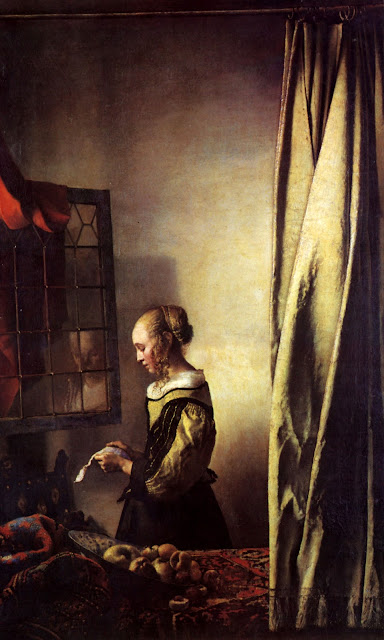 |
| Girl Reading a Letter at a Window, ca. 1657 |
 |
| The Milkmaid, ca. 1660 |
 |
| Lady with Pearl Necklace, ca. 1662 |
 |
| Lady Reading a Letter, ca. 1662 |
 |
| Lady Writing a Letter, ca. 1665 |
 |
| Lady Holding a Balance, ca. 1665 |
 |
| Lady Writing a Letter with her Maid, ca. 1670 |
 |
| Lady Standing at a Virginal, ca. 1670 |
These paintings by Vermeer were not in the Fitzwilliam exhibition whose catalog Desmond Shawe-Taylor was discussing in Apollo when I quoted him yesterday. I chose this group myself to test another, different point brought out in his essay, as follows –
"There was one concept much used in this book that I would suggest belongs in the viewer and not the work: the notion of silence. Paintings, of course, are intrinsically silent, but how can they positively suggest this attribute? They can create a contrast between rowdy and decorous behaviour; they can evoke sounds (and were often commended for doing so): but 'silence' is difficult to separate from concentration, diligence or even the mere fact of being alone. The use of the quality to suggest the emotional core of Vermeer images seems to owe more to an English-speaking collective memory of Keats's famous Ode on a Grecian Urn (1819) – 'Thou still unravished bride of quietness, / Thou foster-child of silence and slow time' – than to anything tangible in Dutch art. Perhaps the beauty and fascination of Vermeer is indeed a 'silent form' that 'dost lease us out of thought / As doth eternity', but in saying this we are trying to find words to describe our feelings, not his paintings."
Desmond Shawe-Taylor makes his point eloquently. On the other hand, Simone Weil (1909-1943) made an equally convincing endorsement of silence as an active spiritual quality dwelling within the painting itself – and not merely a subjective attribution by viewers. "All great painting," she wrote, "gives the following impression: that God is in contact with its point of view regarding the world, with the perspective of it, without either the painter or the person admiring the picture being there to disturb the tête-à-tête. Whence comes the silence of all great painting."